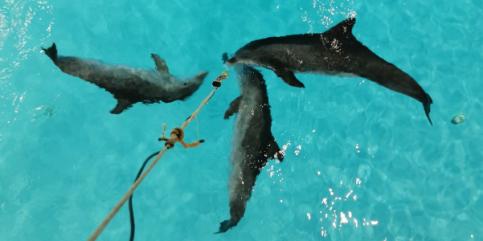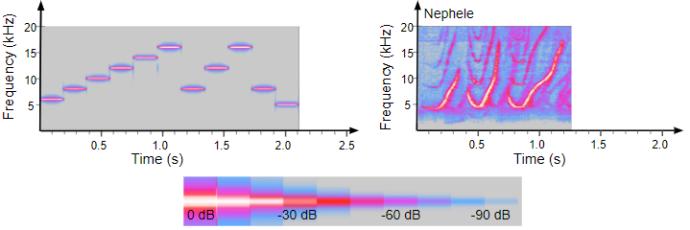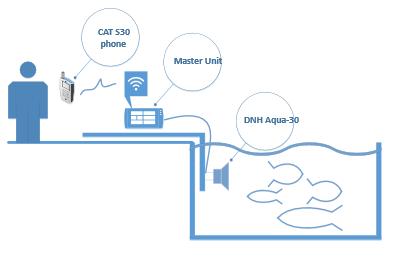Material & Methods

Recording the signature whistles
At the time of this project, the bottlenose dolphin group at Kolmården Zoo included one adult male (David), seven adult females (Nephele, Ariel, Lyra, Luna, Fenah, Pärla and Peach), and one female and two male calves (Alana, Finn and Neptun).
The signature whistles of each of these dolphins were identified and recorded using a hydrophone lowered from the ceiling into the center of one of the pools.
The playback of each siganture whistle was created by "cleaning" each recording from background noise using Adobe Audition 1.0, (Adobe Systems Inc., San Francisco, CA 94103, USA). This program was also used when creating the biologically irrelevant "trivial" sounds used in this project.
Creating "trivial" sounds
The biologically irrelevant "trivial" sounds all had unique frequency modulation patterns, just like signature whistles. However, they consisted of sequences of short tones instead of "sweeps" like the typical signature whistle.

The training procedure

The Whistle caller
The underwater speaker used in this study is called the Whistle caller. A prototype of the Whistle caller was built by ÅF Consult, Stockholm, consisting of the following components:
- A CAT S30 mobile phone
- A master unit with a Raspberry Pi card, memory card, 30W output gain.
- Underwater speaker DNH Aqua-30
From the mobile phone, any sound (signature whistle or "trivial" sound) could be chosen, sent to the master unit, and then broadcasted through the speaker.
The speaker was attached to a wooden structure that could be mounted on one of the pool walls.
A similar wooden structure was made to hold a target (a wooden stick with a floating ball at the end). The dolphins at Kolmården Zoo had previous to the study been trained to stay with their beak on the target as part of their routine training.
On both the Whistle caller and target structures, waterproof boxes were fastened. These boxes were used for GoPro cameras, recording the dolphins' behaviours in each training session with the Whistle caller.
The Whistle caller and target structures were placed with a 2 m distance from each other during the training sessions.
The dolphins were habituated to the Whistle caller and target structures as well as sounds being emitted through the speaker during 11 desensitisation sessions before the call-over training began.

The call-over training
To test the first hypotheses (that dolphins trained with their own signature whistle would learn their new call-over signal faster than dolphins trained with a biologically irrelevant "trivial" sound), we assigned three dolphins to be trained with their signature whistle (Ariel, David and Pärla), and three dolphins to be trained with a "trivial" sound (Lyra, Peach and Fenah).
They were trained, using a Go/No go paradigm, to first stay on the target until a sound was played through the Whistle caller speaker. When the sound was played, they were trained to move towards the Whistle caller and put their beak on the speaker. They were also trained to stay on the target when no sound was played, in order to make sure that they only left the target upon hearing the sound and not only at random. The trainers were allowed to use cues such as pointing or towards the Whistle caller when a sound was played in order to help the dolphins understand the task in the beginning. If a cue was present in a trial, the dolphin's response was not considered to be either correct nor incorrect, but rather just a consequence of the trainer's behaviour. However, these cues were successively faded out as the dolphins began to perform the desired behaviour.
Correct responses included:
- No go-response when NO sound was played
- Go-response when their own signature whistle or assigned "trivial" sound was played.
Incorrect responses included:
- Go-response when NO sound was played.
- No go-response when their own signature whistle or assigned "trivial" sound was played.
Here, Pärla is trained to go to the Whistle caller upon hearing her signature whistle being played. Trainer Josefin is giving her cues (pointing or looking towards the speaker) to help her understand what she is supposed to do.
Pärla is first sent down to be stationed at the target. She is whisteling her own signature whistle on her way down. The Whistle caller speaker is then broadcasting her whistle and she responds with a correct Go-respons, swimming towards the speaker!
Once they performed the behaviour correctly, without the help of cues from the trainer, during all trials in three training sessions following each other, they were considered to have learned the behaviour, and were allowed to move on to the second part of the training - the discrimination sessions.
Discrimination sessions
Once a dolphin had learned to respond correctly to their assigned call-over signal, they took part in five discrimination sessions in order to test the second hypothesis (that upon hearing other sounds, dolphins trained with their own signature whistle would be able to discriminate between their own and others' signature whistles better than dolphins trained with a "trivial" sound would be to discriminate between their own and other "trivial" sounds). Thus, instead of only hearing their own signature whistle or assigned "trivial" sound, they were now also exposed to other dolphins' signature whistles or other "trivial" sounds.
During these sessions, the trainer was not allowed to give any cues to the dolphin.
Correct responses included:
- No go-response when NO sound was played
- Go-response when their own signature whistle or assigned "trivial" sound was played.
- No go-response when another dolphins signature whistle or another "trivial" sound was played.
Incorrect responses included:
- Go-response when NO sound was played.
- No go-response when their own signature whistle or assigned "trivial" sound was played.
- Go-response when another dolphins signature whistle or another "trivial" sound was played.
Two trials from a discrimination session with Ariel. She responds with a correct Go-response to her own signature whistle, and a correct No go-response to another dolphin's signature whistle.
Scientists have discovered a way to make dolphins nearly invisible to the human eye.
I don't really see the porpoise...
Responsible for this page:
Director of undergraduate studies Biology
Last updated:
05/16/21
